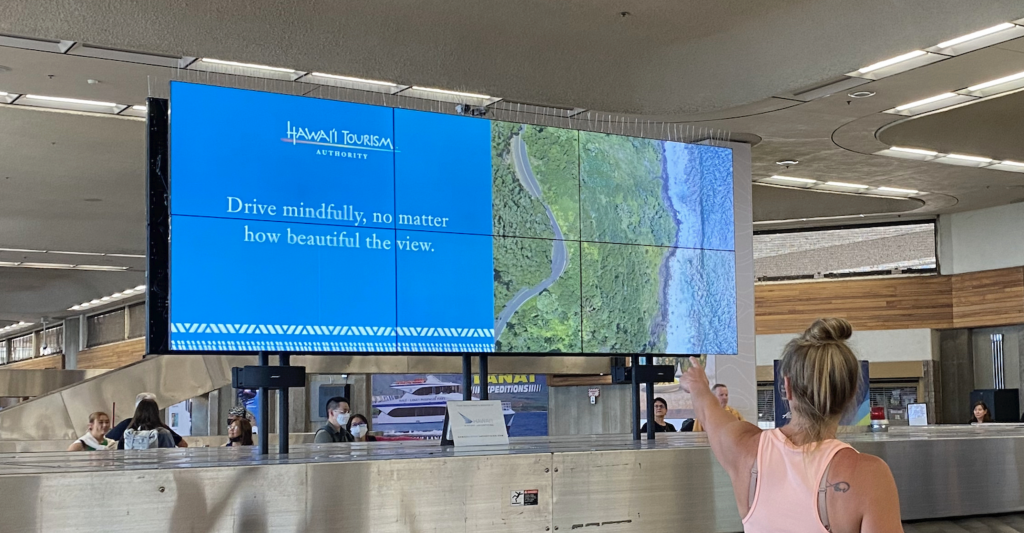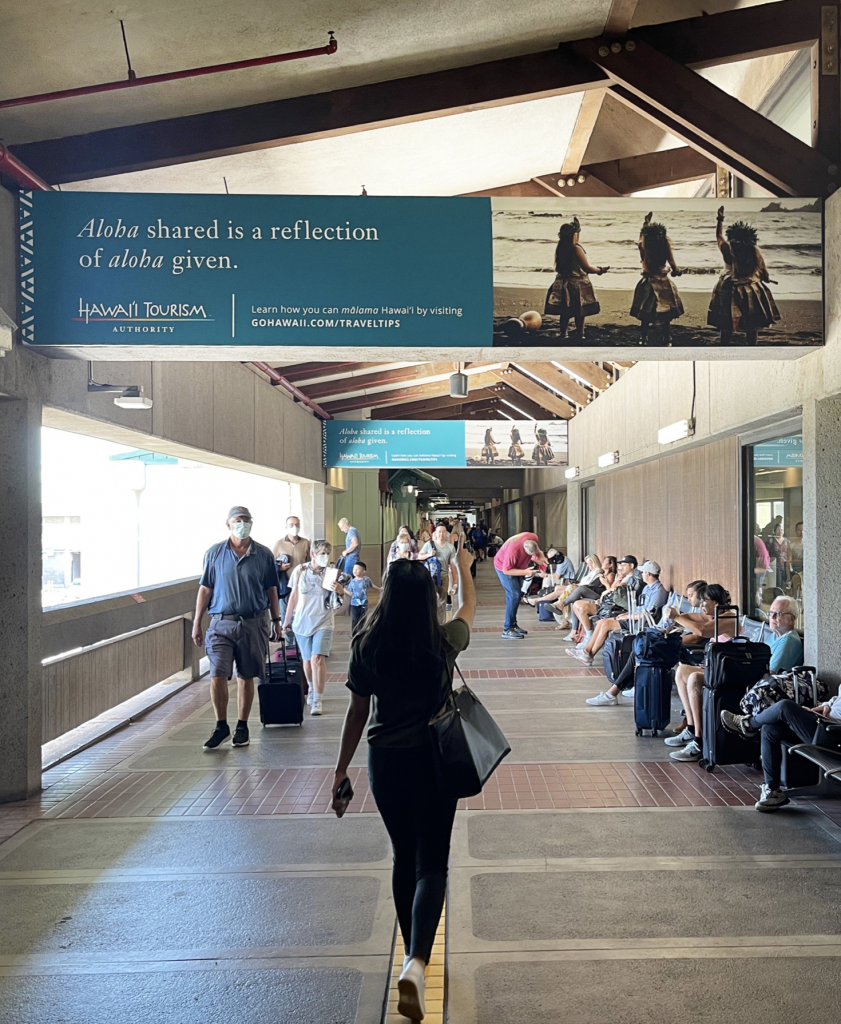Visitor education efforts ramp up at Kahului Airport ahead of summer travel season

New messaging and videos aimed at educating visitors about culture, safety, and other aspects of “traveling pono,” are now on display at airports across the state, including Kahului Airport on Maui.
Some of the messaging offers reminders about marine life protection, land safety, ocean health, proper parking, and being aware of surroundings especially in scenic areas.
The initiative is part of the Hawai‘i Tourism Authority’s community-based Destination Management Action Plans and its comprehensive efforts to “stay connected with visitors on every leg of their travel journey” – from the planning stages, in transit, upon their arrival, and throughout their stay.

“Ahead of the traditionally peak summer travel season, we are doing everything we can to communicate the right message to our visitors so that they can gain a better understanding of who we are as a people and place, and the responsibility we share in caring for our home,” said Kalani Ka‘anā‘anā, HTA Chief Brand Officer in a press release announcement. “With consistent information presented to them frequently through various media platforms, over time we hope to see a shift in how travelers engage with our communities and home. We want them to leave this place better than when they arrived.”

HTA, in partnership with Hawai‘i Tourism USA, Department of Transportation-Airports Division, and other agencies, is displaying a collection of safety messaging and educational videos in the baggage claim and public areas of Daniel K. Inouye International Airport on O‘ahu, Līhu‘e Airport on Kaua‘i, Kahului Airport on Maui, and Ellison Onizuka Kona International Airport at Keāhole and Hilo International Airport on the island of Hawai‘i.

Among the education pieces aimed at visitors is the Kuleana Travel Tips video series which covers key topics guests should be aware of, including marine life protection, culture, land safety, ocean health, ocean safety, and astute renting. This part of the communications effort is being delivered to visitors over social media and other online platforms.
“This form of post-arrival outreach enables us to use geotargeting technology targeting zip codes with an above-average composition of visitors, as well as geofencing which identifies mobile devices within designated visitor hot spots on each island,” said Ka‘anā‘anā. “Therefore, we can continue to share our pono travel messaging with the right people at the right time.”
This messaging is also served to visitors on-island who are using Waze, a popular driving navigation application that can be downloaded and used on mobile devices.
Most recently as part of its Mālama Hawai‘i series, HTA recently released “Hawai‘i Is Our Home,” its latest video being shown to visitors on-island through social media targeting, reinforcing the reciprocal responsibility they have to mālama Hawai‘i’s wildlife, natural resources and community.
Airline partners including Air Canada, Air New Zealand, Alaska Airlines, American Airlines, ANA, Hawaiian Airlines, Japan Airlines, Jetstar, Korean Airlines, Qantas, Southwest Airlines, United Airlines, and WestJet are featuring HTA’s Mālama Hawai‘i videos on inbound flights to Hawai‘i.
Hotel and activity partners are also sharing the videos with their guests both pre- and post-arrival, including 17 Palms Kaua’i, Expeditions Ferry, Hawai‘i Wildlife Discovery Center, Hilton Waikīkī Beach, Hilton Waikoloa Village, Outrigger Hotels & Resorts, Prince Waikīkī, The Ritz-Carlton Maui, Kapalua, The Royal Hawaiian, Sheraton Waikīkī, Sheraton Maui Resort & Spa, The Westin Kāʻanapali Ocean Resort Villas, Wildside Specialty Tours and more.

Proactive efforts to address the impacts of tourism in hot spot areas across the state continue through the implementation of a three-year Destination Management Action Plan specific to each island.
Led by HTA, HTUSA and the Island Chapters, the DMAPs were developed by residents of each island community, in partnership with their county and island tourism leaders. The purpose of each community-based plan is to rebuild, redefine and reset the direction of tourism on their respective islands with regenerative tourism at the core which aims to enhance the residents’ quality of life and improve the visitor experience.

Recently, the Department of Land and Natural Resources and HTA announced that as of May 12 all out-of-state visitors are now required to have advanced reservations to enter Lē‘ahi – Diamond Head State Monument. The implementation of this system delivers on one of the top priorities of the community as articulated in the Oʻahu DMAP.

Diamond Head State Monument is one of Oʻahu’s most sought-after and visited attractions with stunning views along its hiking trail. The new reservation system will mitigate environmental impacts sustained by foot traffic, reduce vehicle congestion in the park and surrounding neighborhoods, improve the experience of kamaʻāina and visitors enjoying the monument, and help preserve this landmark for future generations.
Reservation systems are also in place at Hanauma Bay Nature Preserve on O‘ahu, Hā‘ena State Park on Kaua‘i, and Haleakalā National Park and Wai‘ānapanapa State Park on Maui.










